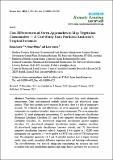Por favor, use este identificador para citar o enlazar a este item:
http://hdl.handle.net/10261/153591COMPARTIR / EXPORTAR:
 SHARE SHARE
 CORE
BASE CORE
BASE
|
|
| Visualizar otros formatos: MARC | Dublin Core | RDF | ORE | MODS | METS | DIDL | DATACITE | |

| Título: | Cost-Effectiveness of Seven Approaches to Map Vegetation Communities — A Case Study from Northern Australia’s Tropical Savannas |
Autor: | Lewis, Donna; Phinn, Stuart; Arroyo, Lara CSIC | Fecha de publicación: | 18-ene-2013 | Editor: | Multidisciplinary Digital Publishing Institute | Citación: | Remote Sensing 5 (1): 377-414 (2013) | Resumen: | Vegetation communities are traditionally mapped from aerial photography interpretation. Other semi-automated methods include pixel- and object-based image analysis. While these methods have been used for decades, there is a lack of comparative research. We evaluated the cost-effectiveness of seven approaches to map vegetation communities in a northern Australia’s tropical savanna environment. The seven approaches included: (1). aerial photography interpretation, (2). pixel-based image-only classification (Maximum Likelihood Classifier), (3). pixel-based integrated classification (Maximum Likelihood Classifier), (4). object-based image-only classification (nearest neighbor classifier), (5). object-based integrated classification (nearest neighbor classifier), (6). object-based image-only classification (step-wise ruleset), and (7). object-based integrated classification (step-wise ruleset). Approach 1 was applied to 1:50,000 aerial photography and approaches 2–7 were applied to SPOT5 and Landsat5 TM multispectral data. The integrated approaches (3, 5 and 7) included ancillary data (a digital elevation model, slope model, normalized difference vegetation index and hydrology information). The cost-effectiveness was assessed taking into consideration the accuracy and costs associated with each classification approach and image dataset. Accuracy was assessed in terms of overall accuracy and the costs were evaluated using four main components: field data acquisition and preparation, image data acquisition and preparation, image classification and accuracy assessment. Overall accuracy ranged from 28%, for the image-only pixel-based approach, to 67% for the aerial photography interpretation, while total costs ranged from AU$338,000 to AU$388,180 (Australian dollars), for the pixel-based image-only classification and aerial photography interpretation respectively. The most labor-intensive component was field data acquisition and preparation, followed by image data acquisition and preparation, classification and accuracy assessment. | Versión del editor: | https://www.mdpi.com/2072-4292/5/1/377 | URI: | http://hdl.handle.net/10261/153591 | DOI: | 10.3390/rs5010377 |
| Aparece en las colecciones: | (CCHS-IEGD) Artículos |
Ficheros en este ítem:
| Fichero | Descripción | Tamaño | Formato | |
|---|---|---|---|---|
| remotesensing-05-00377.pdf | 8,86 MB | Adobe PDF |  Visualizar/Abrir |
CORE Recommender
SCOPUSTM
Citations
17
checked on 29-mar-2024
WEB OF SCIENCETM
Citations
15
checked on 13-feb-2024
Page view(s)
358
checked on 19-abr-2024
Download(s)
276
checked on 19-abr-2024
Google ScholarTM
Check
Altmetric
Altmetric
Este item está licenciado bajo una Licencia Creative Commons

